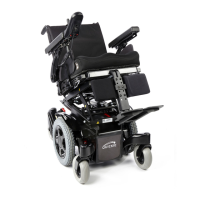11.3 Safety cut-outs
In the event of a short circuit there are several safety
systems built into your wheelchair to safeguard your
electrical circuits.
• Fusible 100A links are connected into the battery
harnesses to protect the batteries and wiring.
• A 15A fusible link. (When Quickie Direct Actuator
Control Box is fitted or other modules requiring auxiliary
power). This is located behind the front shroud.
To replace them contact your Sunrise Medical authorised
dealer, who will also diagnose the fault.
R-net Control
Please refer to your R-net Owner’s Manual for
details.
11.4 General battery information
Batteries are the power source for almost all of the modern
mobility products available today. The design of batteries
used in mobility products is significantly different to the
batteries used to start a car for example. Car batteries are
designed to release a large amount of power over a short
period of time, whilst mobility batteries (commonly called
deep cycle batteries) release their power evenly, over a
long period of time. Therefore, due to the lower production
volumes and increased technological requirements,
mobility batteries are typically more expensive.
Commonly two 12 volt batteries are used together in a
mobility product, giving a total voltage of 24 volts. The
size of the battery (e.g. its available power) is expressed
in amps per hour e.g. 80amp/hr. The higher the number,
the bigger the battery size, weight and, potentially, the
greater the distance you can travel. Sunrise Medical only
fit as standard maintenance free batteries into these types
of wheelchairs.
11.5 Maintenance free batteries
This type of battery uses a method of carrying the
electrolyte commonly referred to as ‘gel’, that is held within
the battery case. As the name implies, no maintenance
is required other than regular charging. You can safely
transport this type of battery without fear of acid spilling.
Furthermore, they are approved for transportation on
aircraft, trains and ships.
11.6 Battery care
Below is set out a battery care plan for maintenance free
batteries. This has been agreed between Sunrise Medical
and the battery manufacturers, to enable you to get the best
out of your batteries. If a different care plan is followed, this
may result in lower than expected performance from your
mobility vehicle.
11.7 Maintenance free battery care plan
WARNING!
Only use an approved Sunrise Medical charger compatible
with the vehicle to be charged.
• Charge your batteries every night, regardless of the
amount of use your mobility device has had during the
day.
• Do not interrupt the charging cycle.
• If your mobility device is not required for use, it should
remain connected to the charger until required. This
will not damage your batteries, as long as the mains
socket/plug is left switched on. Turning the mains
socket/plug off, but leaving the mains cable plugged in
will eventually deplete your battery charge.
• If you intend to leave your vehicle for an extended
period (more than 15 days) charge the batteries fully
and then disconnect the main battery lead.
CAUTION!
• Failure to allow for recharge will damage the batteries
and can lead to shortened distances and premature
failure.
• Do not top up the charge of your batteries during the
day. Wait until the evening for a full overnight charge.
As a general rule, maintenance free batteries take longer
to fully charge than lead acid batteries.
The battery terminals need to be checked regularly for
signs of corrosion. If any corrosion is apparent, then
clean the terminals completely (a wire brush is ideal) and
re-grease the terminal using Vaseline petroleum jelly, not
ordinary grease. Ensure that the terminal nut and bolt,
cable clip and exposed cable are completely covered with
jelly.
Following all the points above should result in a healthier
battery, greater range for the vehicle user and a longer life
for your batteries.
Return the batteries back to Sunrise Medical or directly
to the battery manufacturer for recycling, when they no
longer hold charge.

